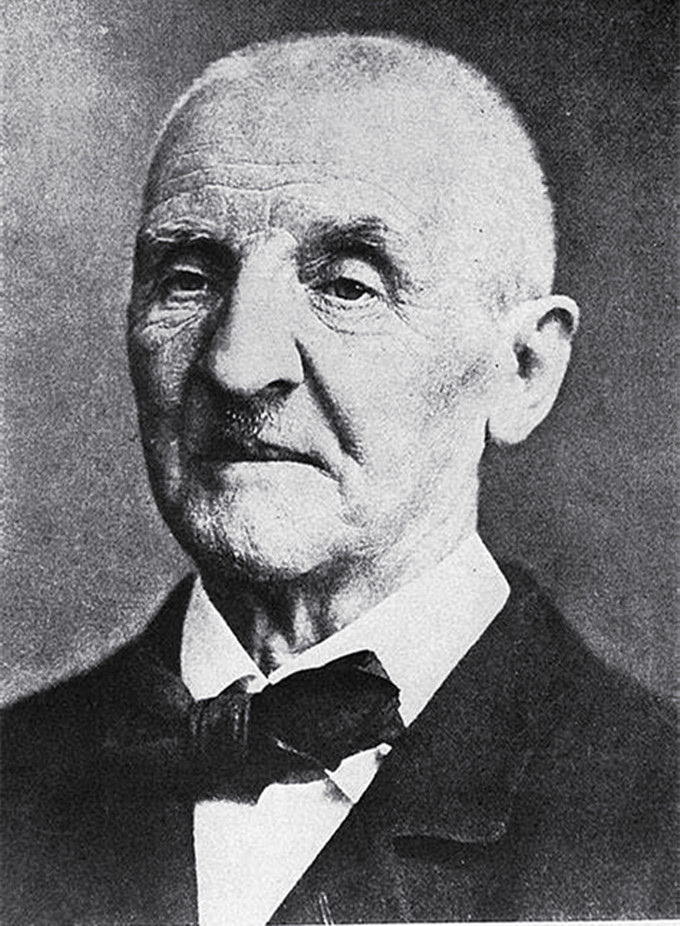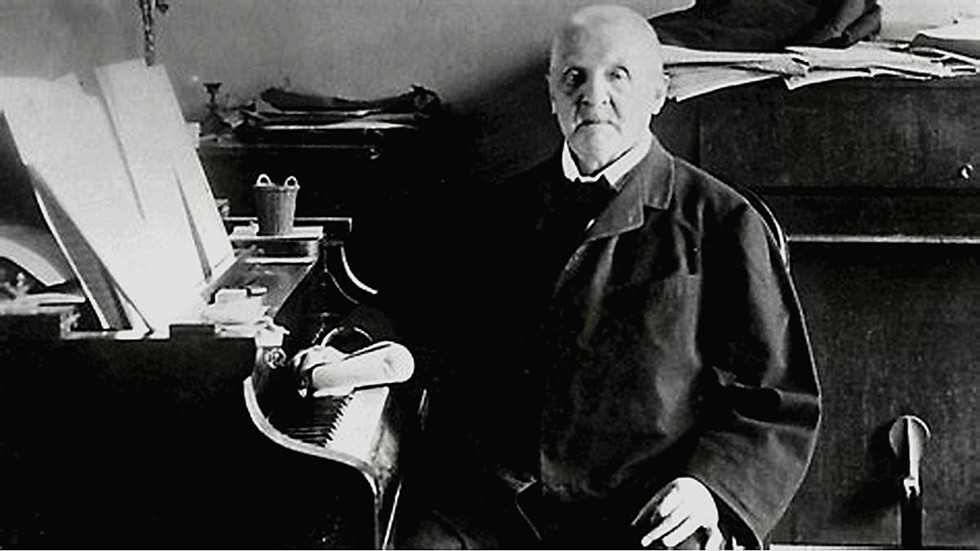| |
|
|
|
|
|
|
|
|
|
|
| |
| |
 |
|
| |
田润德
编译
文/图 2020-01-18 16:36 |
|
| |
|
|
|
|
| |
 |
|
|
|
| |
安东·布鲁克纳(Anton·Bruckner,1824-1896) |
|
|
|
| |
|
|
|
|
| |
|
|
|
|
| |
布鲁克纳第七交响曲 约胡姆指挥
|
|
|
|
| |
|
|
|
|
| |
音乐历史上的今天
1883年1月22日,布鲁克纳(Anton·Bruckner)开始为自己的《第七交响曲》谱写辉煌的柔板。“我回到家以后感到十分悲伤。我一想到大师(瓦格纳
Richard Wagner)将不久于人世,脑海中便浮现了升C小调柔板主题。”
布鲁克纳在构思他的第七交响曲柔板乐章的时候,他就已经预感到瓦格纳的死亡,每当想到他所崇拜的偶像瓦格纳命悬一线、危在旦夕,他的悲情气质让他不得不油然而生这首升C小调柔板的主题,这也是天意!
悲随着音乐来临,我甚至感觉到了恐怖。柔板乐章的主题以瓦格纳大号来演奏,并在整个乐章中反复出现,以此构成一首低沉的挽歌。随后,这支动人心弦的挽歌经过漫长的行进,在乐队全奏中达到庄严、肃穆、辉煌的高潮,布鲁克那在此强调,“请用极慢的速度、十分庄严”地演奏,我们可以想象,这是对逝去的大师表达敬意的时刻;高潮过后,有一个宁静的尾声,仿佛万物在夜幕中沉寂,那是真正的葬礼音乐。
布鲁克纳 E大调第七交响曲(BRUCKNER Symphony No.7 in E
major),由奥地利作曲家布鲁克纳于年创作,作于1881-1883年。评论家们称作为《英雄交响曲》。创作这首作品时,正直瓦格纳去世,其中第二乐章为瓦格纳的悼歌。共4乐章
。1884年在莱比锡首演之后,成为了布鲁克纳的第一部攀上欧洲乐坛的名作,这部作品使得布鲁克纳终于得到了人们的认可。
安东·布鲁克纳(Anton·Bruckner,1824-1896),奥地利著名作曲家,管风琴家;1824年9月4日生于林茨附近的安斯费尔登。
他早在13岁参加圣弗洛里安修道院唱诗班,并学管风琴;1856年任林茨大教堂管风琴师,1868年在维也纳音乐学院执教,翌年起先后到法国、英国、瑞士旅行演出;1875年任维也纳大学和声、对位讲师,1891年获名誉哲学博士学位。
与很多音乐大师们确实不同,布鲁克纳是一个穿着古怪的大器晚成者。他身材短小、衣着土气、行为乖僻,并且是一个极度虔诚的天主教徒,这与当时19世纪晚期作曲家追求的浪漫主义形象显得格格不入。然而,在那浪漫的奥地利宗教生活的熏陶下,他创作的音乐作品让人们强烈地感受到圣弗洛里安教堂深奥莫测与神秘冥想的气息。
作为一个完美主义者,他不厌其烦、反反复复修改自己的作品,不达目标决不面世,苍天不负有心人,终于写出了像《第七交响曲》升C小调柔板这样动人心魄绝妙乐章。
他的音乐作品除一部序曲和一部弦乐五重奏外均为交响曲,共10部;这些交响曲气势巍峨,色彩明朗,兼用古典派贝多芬和浪漫派舒伯特的传统技巧,以及古代众赞歌的手法和后期浪漫派的音调,内容多数描写精神世界;布鲁克纳他对瓦格纳敬仰备至,3部弥撒曲和第一交响曲在和声、配器方面深受瓦格纳影响,第3交响曲以瓦格纳为标题,第7交响曲柔板乐章是悼念瓦格纳之作;但其作品在生前多遭冷遇,他去世后多年才渐受重视。
1896年10月11日在维也纳逝世,终年72岁。
今日视频:约胡姆指挥布鲁克纳第七交响曲
欧根·约胡姆(Eugen Jochum,1902年11月1日-1987年3月26日),生于巴本豪森,巴伐利亚,逝于慕尼黑,是德国著名指挥家。
约胡姆是一位风格纯正,修养深邃的老指挥大师,这已是如今人们所一致公认的评价,他的朴实、端正和深奥的艺术风格,的确是一种具有持久生命力的艺术风格,当今天人们已经厌恶了那种靠一时激情和哗众取宠来取悦听众的浮浅风格后,反过来再回顾和领略一下约胡姆那货真价实的艺术风格,便更加觉得它是那样的精致、珍贵和具有永久意义了。
|
|
|
|
| |
Today in music history
On January 22, 1883, Anton Bruckner began to write a magnificent adagio
for his seventh symphony."I came home feeling very sad.The adagio theme
in C sharp minor comes to mind when I think of [Richard Wagner] dying."
When bruckner was working on the adagio movement of his seventh
symphony, he had already foretold the death of Wagner. Whenever he
thought that his idol Wagner was in danger, his tragic temperament made
him feel compelled to bring up the adagio theme of this song in C sharp
minor.
The sadness comes with the music and I even feel the terror.The theme of
the adagio movement is played in Wagnerian tuba and is repeated
throughout the movement to form a low elegy.Then, after a long march,
the moving elegy reaches a solemn, solemn, glorious climax in the full
orchestra, and bruckner emphasizes, "please play it very slowly, very
solemnly," a moment of homage to the departed master, as one might
imagine;After the climax, there is a peaceful end, as if everything is
silent in the night, that is the real funeral music.
BRUCKNER Symphony No.7 in E major was composed by Austrian composer
BRUCKNER in 1881-1883.Critics called it the symphony of heroes.At the
time of this composition, Wagner died, and the second movement is
Wagner's eulogy.There are four movements.After its debut in leipzig in
1884, it became bruckner's first European masterpiece, which finally
brought bruckner to public recognition.
Anton Bruckner (1824-1896) was an Austrian composer and organist.He was
born on September 4, 1824, in ansfield, near linz.
As early as the age of 13, he joined the choir of st. florian's
monastery and learned the organ.In 1856, he was the organist of linz
cathedral. In 1868, he taught at the Vienna conservatory of music.In
1875 he was a lecturer in harmony and counterpoint at the university of
Vienna, and in 1891 he received an honorary doctorate of philosophy.
Unlike many great musicians, bruckner is a late bloomer who dresses
oddly.He was short, rustic, eccentric and deeply Catholic, at odds with
the romantic image sought by composers of the late 19th century.However,
influenced by the romantic Austrian religious life, his musical works
strongly remind people of the esoteric and mystical meditation of st.
florian's church.Bruckner was a perfectionist, and the unmodified
completely qualified never came out.
Apart from an overture and a string quintet, his musical works are all
symphonies, a total of 10;These symphonies are magnificent and bright in
color. They use the traditional techniques of classical Beethoven and
romantic schubert, as well as the techniques of ancient hymns and later
romantic tones.Bruckner admired Wagner. The three mass pieces and the
first symphony were deeply influenced by Wagner in terms of harmony and
orchestration.But his work was largely ignored during his lifetime, and
it took years after his death for his work to gain traction.
He died in Vienna on October 11, 1896, aged 72.
Today's video:
Eugen Jochum (November 1, 1902 -- March 26, 1987), born in Bavaria, died
in Munich, was a famous German conductor.
Around the country, a style is pure, cultivation of depth of the old
masters command, it is now accepted by people, he guileless, correct and
profound artistic style, is a kind of lasting vitality of artistic
style, when people are sick today by the passion and snorkelling style
of grandstanding to please the audience, in turn, to review and
appreciating the artistic style, about the country that actually will be
more feel that it is so delicate and precious and permanent
significance.
|
|
|
|
| |
|
|
|
|
| |
 |
|
| |
布鲁克纳(Anton·Bruckner) |
|
|
|
| |
|
|
|
|
| |
布鲁克纳是浪漫主义时期最著名的作曲家之一,就连当时如日中天的瓦格纳对于这位年纪比自己小了近一轮的作曲家也心存敬意,居然将他与自己的偶像贝多芬相提并论;在那个大变革的年代,世事万物都经历着翻天覆地的变化,瓦格纳将歌剧发展到了一个令后人无法逾越的高峰,整个欧洲的音乐笼罩在瓦格纳的影子之下,这在布鲁克纳的音乐中颇有体现。英雄是当时的时代主题,不少人写过英雄的乐章,而布鲁克纳的“英雄”当属这部E大调第七交响曲;这部交响曲既有宏伟的史诗规模,又在曲式上有着大胆的创新,拓展了交响曲的形式。尽管它依然保留了传统的四个乐章的形式,但是仅有第三乐章与奏鸣曲式结构相似。
第一个乐章是一个中庸的快板。乐章的一开头犹如清晨的烟雾渐渐升腾弥漫,很有《罗恩格林》序曲的意境,第一乐章便在这种安详与柔和中展开,木管的缥缈与弦乐声部的轻柔反复最终汇聚成一股不断升华的主题,并在管乐的雄壮威严的号角中将乐章带入一种宽广坦荡的气氛,而在木管声部的再次独奏后,乐曲似乎进入了一种神秘肃穆的境界,铜管声部庄严的令人略感不祥的感召后,乐曲又恢复了先前的平静,而这种看似平和的气氛下却孕育着荡气回肠的激情,经过几次回旋往复之后,乐曲进入又回到了刚刚开始的那个安详的主题,而这一次却在弦乐营造出来的不断上升的氛围下升华并超脱,最终犹如日出云层般的绚烂辉煌。
第二乐章是这部交响曲最著名的乐章,不仅仅因为这个柔板竟然长达23分钟,而是因为无论从感染力还是这个乐章在以后引来的非议都促使它成为音乐史上最着名的柔板之一。
布鲁克纳创作这部乐曲时,刚好得到瓦格纳去世的消息,而且作曲家还在其中运用了瓦格纳大号的着名乐段,所以这一乐章被认为是为瓦格纳所创作的挽歌。乐曲庄严而缓慢,表达哀愁但并不伤感,却有感恩赞的崇高,并将弦乐的颤音发挥到极致。这篇升华的乐章之中,时而插有温暖抒情的旋律,也许寄托了对美好往事的怀念。旋律击罄于耳边,却回荡在心间,耳所闻,心所思,情所动,如何令人不泪颜。乐曲升华到极致,如夕阳般辉煌,此后又静谧安详,如秋叶般凄美沧桑。和理查·施特劳斯的《死与净化》有着异曲同工之妙,却又多了一分庞然大气。
第三乐章是一个很快的谐谑曲,铜管乐主导下的主题激情飞扬,有如滔滔江水,势不可挡,有如对不平命运的反抗。中间的部分却缓慢而柔和,似乎是对第一乐章的回应。终乐章是一个不太快,但是很激动的快板。小提琴轻盈跳跃的前奏引来了一个博大的主题。铜管乐令人紧张而阴暗的命运主题打断了这种安详,而后便是悲怆的反击主题。这一过程反复出现,而每次雄壮庄严的主题过后都紧紧跟随着高洁如圣咏的弦乐主题及其变形。最后乐章又回到了开始那个蠢蠢欲动的主题,并升华到无比宏伟的气势,宛如天国般壮观,仿佛是对死亡的战胜。 |
|
|
|
| |
|
|
|
|
| |
Bruckner was
one of the most famous composers of the romantic
period, and even Wagner, in his heyday, paid homage
to a composer who was nearly a generation younger
than himself, comparing him to his idol Beethoven.At
that time of great change, everything was undergoing
tremendous changes, and Wagner developed the opera
to an insurmountable peak. The music of the whole
Europe was under Wagner's shadow, which was
reflected in bruckner's music.The hero is the theme
of The Times, many people wrote the hero movement,
and bruckner's "hero" should belong to the 7th
symphony in E major;This symphony not only has a
magnificent epic scale, but also has a bold
innovation in the form, expanding the form of the
symphony.Although it retains the traditional
four-movement form, only the third movement is
similar to the sonata structure.
The first movement is a moderate allegro.Movement of
the beginning is like the gradually rising smoke
rose early in the morning, "RON green" prelude of
artistic conception, the first movement in this
serene and soft, wind, ethereal and string parts of
soft repeatedly eventually converge into a rise of
the subject, and in the magnificent majestic horn
that wind movement into a broad magnanimous
atmosphere, and again in the woodwind voice solo,
the music seems to enter the state of a kind of
mysterious solemn, brass parts solemn a mildly
sinister, to inspire music previously calm again,
but this seemingly peaceful atmosphere gestates
resonant passion,After a few twists and turns, the
music returns to the serene theme of the beginning,
this time sublimated and detached in the rising
atmosphere created by the strings, and finally
resplendent like the clouds of sunrise.
The second movement is the most famous movement of
the symphony, not only because the adagio is 23
minutes long, but because both its appeal and the
subsequent criticism of the movement have made it
one of the most famous adagio in music history.
Bruckner wrote the piece just as news of Wagner's
death broke, and the composer used Wagner's famous
tuba in it, so this movement is considered an elegy
for Wagner.The music is solemn and slow, elegiac but
not sentimental, yet sublime in gratitude, and takes
the vibrato of the strings to its fullest.This
sublimation of the movement, sometimes inserted with
a warm lyrical melody, perhaps pinned on the memory
of the good old days.Melody hit in the ear, but
echoed in the heart, the ear heard, heart thinking,
feeling moved, how to make people not tears.Music
sublimated to the extreme, like the setting sun,
after the quiet and quiet, like autumn leaves as
beautiful vicissitudes of life.It is similar to
Richard strauss's "death and purification", but with
an extra dimension.
The third movement is a quick scherzo, in which the
theme, under the direction of brass, is as
passionate as a river, as unstoppable as a revolt
against injustice.The middle part is slow and soft,
as if in response to the first movement.The finale
is a not too fast, but very exciting allegro.The
violin's lithe, leaping prelude leads to a broad
theme.This serenity is interrupted by a tense and
dark theme of fate in brass, and then by a sorrowful
counter-theme.This process recurs over and over
again, and each time the grand and solemn theme is
followed closely by the string theme and its
transformation of the grand chants.The last movement
returns to the stirring theme of the beginning, and
rises to the height of the sublime, the heavenly
grandeur, the triumph of death.
|
|
|
|
| |
 |
|
|
|
| |
欧根·约胡姆(Eugen Jochum) |
|
|
|
| |
欧根·约胡姆(Eugen Jochum,1902年11月1日-1987年3月26日),生于巴本豪森,巴伐利亚,逝于慕尼黑,是德国著名指挥家。
约胡姆是一位风格纯正,修养深邃的老指挥大师,这已是如今人们所一致公认的评价,他的朴实、端正和深奥的艺术风格,的确是一种具有持久生命力的艺术风格,当今天人们已经厌恶了那种靠一时激情和哗众取宠来取悦听众的浮浅风格后,反过来再回顾和领略一下约胡姆那货真价实的艺术风格,便更加觉得它是那样的精致、珍贵和具有永久意义了。 |
|
|
|
| |
|
|
|
|
| |
Eugen Jochum (November 1, 1902 - March 26, 1987),
born in Babenhausen, Bavaria, died in Munich, is a
famous German conductor.
Johum is an old master conductor with a pure style
and profound cultivation, which is now generally
recognized by people. His simple, upright and
esoteric artistic style is indeed an artistic style
with lasting vitality. Today, after people have
disliked the superficial style of pleasing the
audience by temporary passion and grandstanding,
when they look back and appreciate Johum's genuine
artistic style, they feel that it is so delicate,
precious and permanent. |
|
|
|
| |
|
|
|
|
| |
【帝国慢板】 富特文格勒/布鲁克纳第七交响曲 第二乐章
|
|
|
|
| |
柏林爱乐乐团/富特文格勒
1942/4/7录音这一版本的录音被称为“帝国慢板”
这个版本的录音在1945年5月1日德国广播宣布希特勒死讯之前被播出。在1943年1月31日德国广播宣布德军在斯大林格勒战败的消息之前,也播出了这个乐章(版本未知)。 |
|
|
|
| |
|
|
|
|
| |
Berlin
philharmonic/furtwangler recording this version of
the recording is known as the "imperial adagio" this
version of the recording was broadcast before the
announcement of Hitler's death on German radio on 1
May 1945.This movement (version unknown) was also
broadcast on January 31, 1943, before the German
radio announced the German defeat at stalingrad. |
|
|
|
| |
|
|
|
|
| |
未得原作者编者授权严禁转载www.mt77.com任何内容 |
|
|
|
|
|
|
|
|
|
|
|
|
|
|


